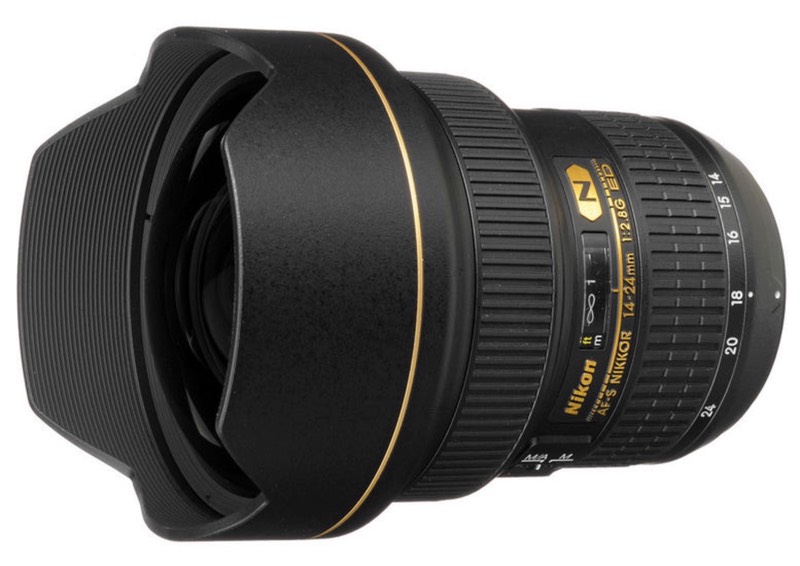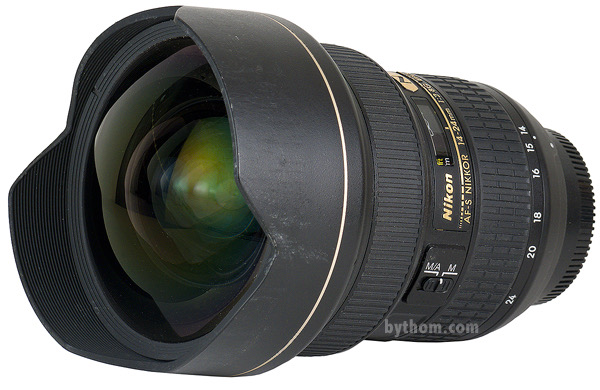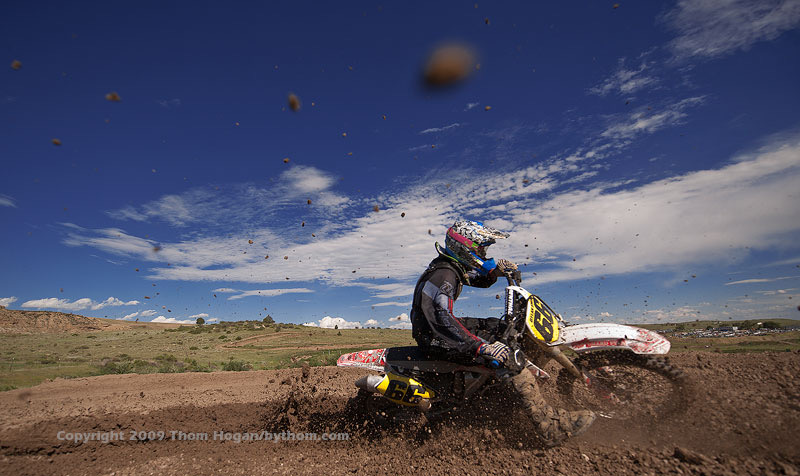"Fear has big eyes." —Russian proverb

This review originally appeared on the bythom.com site in 2009. It has been revised and updated for the dslrbodies.com site.
What is it?
The Nikkor 14-24mm f/2.8G is distinguished by the massive curved front element that sits out front. To a lot of potential buyers, this bulging hunk of glass sends waves of fear up and down their spine. "I'm going to scratch it!" they'll scream, and walk quickly over to the part of the counter where a 17-35mm or 16-35mm lens sits and stroke it to calm themselves down.
Those that remain staring at the massive front element on the 14-24mm eventually realize there aren't any filter threads. "I can't use my polarizer on it!" they scream and quickly join their former colleagues over at the 17-35mm and 16-35mm display. Since I was the only one left, I just bought the 14-24mm and went out shooting with it ;~).
All that glass adds up. The lens is a bit over two pounds (969g) and has a slightly over 5" front diameter. This isn't my mentor's wide angle lens, by any means: the lens cap alone would gobble that up and hide it front sight. That cap is a push-on one that goes over the built-in and minimal petal lens hood, eventually scarring the plastic on the hood (which you can see in the image below).

The optical formula is 14 elements in 11 lens groups. Two of them are ED (Extra-low Dispersion) elements and three are aspherical to help keep chromatic aberrations at bay. Nano coating and Super Intergrated Coating help keep internal reflections to a minimum.
The lens covers both DX and FX formats, presenting a 61 to 90° degree angle of view (diagonally) on DX, and 84 to 114° on FX. Close focus is just under a foot (.28m), presenting a maximum magnification of 1:6.6. The lens does not have VR, nor does it have accomodations for filters (front, back, or drop-in). There is no tripod mount on the lens (nor would one really expect one on a lens like this one). The lens has a focus scale , but no DOF markings. As with most high-end Nikkors, there are 9 aperture blades. There's dust/moisture protection built in.
The lens comes with a soft shell case for US$1899. The lens is made in Japan.
Nikon's page for the lens is here.
Source of the reviewed lens: purchased
How's it Handle?
It seems I'm dealing with the heavyweight lenses in this review batch. This is no light lens, and it's short 5"+ length means that weight is packed in a tight space. The lens balances quite well on the D5 and D850 pro bodies, but on something smaller such as the D7500 (or worse, the D5600), you're going to have a front-heavy concoction on your hands. That's okay, as you'll have a hand underneath this lens so that you can zoom (the zoom is closest to the body, just where I like it).
The focus ring is on the front of the lens and pretty easy to find. The diameter change between focus and zoom rings makes it easy to distinguish that you've moved from one to the other, a subtle but important touch. The lens has only a M/A M switch besides the rings. Minimal controls to hunt for and find, let alone set correctly. As with many AF-S Nikkors, the focus ring has a little bit of slop to it when engaging the internal cam and, after a lot of use and abuse, is now a little on the noisy side. The zoom ring is less resistent headed to 14mm than it is to 24mm. The resistance going to 24mm is about what I'd expect, the lightened resistence headed the other way tends to make me overshoot where I was trying to go when I'm in a hurry.
The barely protected front element means you have to watch out from bumping things (especially when you're at 14mm and looking through the viewfinder--some objects may be closer than they appear). That means more cleaning, too. This big front element tends to collect more dirt and dust compared to my old 17-35mm. However, as many of you know, I'm not exactly too careful with this lens:

Yes, that's dirt balls headed right toward the front element.
By the end of this shooting session, the lower half of the lens hood had collected quite a bit of dirt. I could also see that the lens had taken five direct hits on the glass itself (the mud imprints were pretty clear ;~). Did I panic? Did I scream at the loss of my lens? Did I break down and cry? No, no, and no. I dumped out the dirt, got out my cleaning kit, did some impromptu field cleaning, and went back to shooting. The glass? No marks. No scratched coating. Don't get me wrong, you can certainly damage the front element of a lens that's vulnerable like this one, but most people get their fear quotient dialed up way too high with this lens. I don't pamper mine, as the above shot certainly shows (I'm at 14mm, so that bike is pretty darned close to the camera). I don't think you should pamper yours, either. But do carry cleaning equipment around with you. More so than the other lenses I carry with me on shoots, I find myself cleaning this one more than the others.
How's it Perform?
The MTF charts on Nikon's site show a lot of complexity. Complex it is. It's a little difficult to categorize exactly how the lens performs because we've got a lot of variables.
Let me start by saying that it's better at 14mm on an FX camera in the corners than than the old 17-35mm I used to use was at any focal length. By a considerable and visible margin. Certainly not perfect, but visibly better. The details for FX users:
- At 14mm the lens is excellent at all apertures. It takes f/4 to fully pull the corners into match the center, but even at f/2.8 the corners are very acceptable in sharpness. Barrel distortion is over 1% and slightly complex. Vignetting is high, perhaps a stop-and-a-half in the corners wide open, which improves to about a half stop at f/8 and never gets better than that.
- Curiously, the mid-range focal lengths (say, 16mm), seem weaker (and show a slight bit of decentering on my sample: left edge isn't quite as good as the right). Again, f/4 will pull in the corners. The mid-range focal lengths still show some barrel distortion, but less overall and less complex.
- At 24mm the lens the lens is back close to the 14mm performance, though the corners never quite catch up to the center sharpness. Distortion is near zero. Vignetting is less than a stop wide open and perhaps a third of a stop by f/8.
- The only real optical issue that should concern you is that this lens, like a lot of wide angle zooms, has some field curvature to it. Be careful about where you put the focus cursor, and understand how field curvature can impact your landscapes.
Yes, it still holds up well with the D850, though make sure you know how the field curvature works, as it will definitely show up with all those pixels.
Chromatic aberration is present in modestly visible amounts, and worse at 24mm than 14mm.
So here's the question: is it worth getting this lens if you have a DX camera? I'm going to take a somewhat controversial stance here: no. Basically, we're talking about a 21-36mm zoom on DX. A good one, sure, but big, heavy, and not really a great match to the DX concept of smaller and lighter. Simply put, DX users have other better choices. If you need fast aperture, the Tokina 11-16mm or 11-20mm f/2.8 are smaller, lighter, and a very close match to what FX users get with the 14-24mm. Hey, and they take 77mm filters. If you're not hung up on fast aperture, both Nikon wide angle DX zooms are better choices for DX users, as well. Plus you've got the Sigma options, as well. In short, DX users have plenty of wide angle zoom options to pick from, ones that are far better matched to their cameras.
As you might expect from a wide angle lens, focusing is generally swift. However, note that on some Nikon DSLR bodies, 14mm means you're putting a lot of detail into a single autofocus sensor. As Nikon notes in their manuals, there are conditions where far detail can fool the autofocus system with wide angle lenses. Trust, but verify.
Final Word
The 14-24mm is a fantastic lens. Optically, it's everything I've ever wanted in a wide angle zoom, and it's a clear cut above the much loved 17-35mm in that respect. If you really have to have filter capability, you can get a very expensive filter holder kit (which in turn uses expensive 150mm filters; see link below). Since getting the 14-24mm, I've shuffled my 17-35mm off to the farm to enjoy its retirement in peace. The extra angle of view and better resolution, coupled with some other strong performance aspects don't have me missing filters. The only filters I'd ever want to use on this lens anyway would be NDs.
Compared to the Sigma 14-24mm f/2.8 Art: this is a tough call. I spent a couple weeks with a loaner Sigma and my impressive is this: it's sharp, maybe sharper than the Nikkor. But it's edgy sharp. By that I mean that that Nikkor rolloff from the focus plane to the out of focus area just isn't matched. The Sigma feels busier in all bokeh-type assessments, and some of the Art lenses just have this artificial feel to the acuity to me. Some will like that. As I said, it's sharp. But it's neither Nikkor sharp nor Zeiss sharp; I'm just not sure how to describe it. Of course, it's US$600 cheaper than the Nikkor, and if you're pressing this on a D8xx body at landscape apertures, the diffraction impact takes a bit of the edge off.
Update: Several companies make filter adapters for the 14-24mm that take 150mm or other large size filters. For example Sensei [advertiser link]. Also, a soft lens cover that's elastic, like the LensCoat Hoodie [advertiser link] is a good accessory to have.
Recommended (2009 to present)
Support this site by purchasing from the following advertiser:
